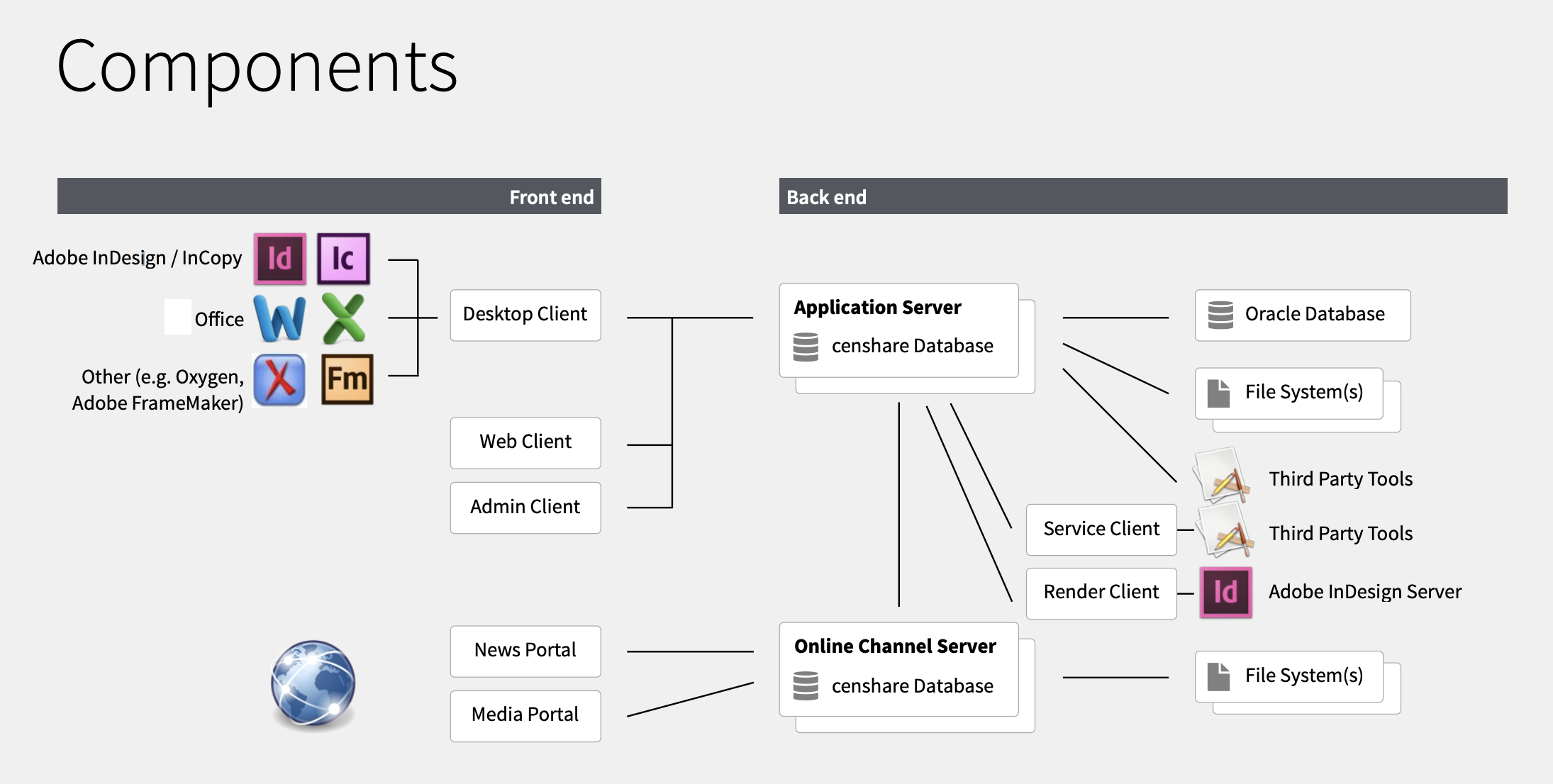Architecture overview
censhare is a universal content management platform that centralizes and automates all content and processes to give our customers the freedom to create engaging content and customer experiences across all channels.
The censhare architecture consists of three tiers:
- frontend tier with client applications
- server tier with application servers
- data storage tier with database and file systems

Each tier in censhare hosts several components with logical entities. Together with a set of services, they form the entire functionality of the censhare platform.

Application Server
The Application Server provides about 40 built-in services for the censhare core functionality and about 350 modules for specific functions. The Application Server provides the domain logic for asset management. It is a stand-alone application running on Java Runtime Environment. The Application Server can scale horizontally for load balancing and high availability.

Many services and modules are ready to use and just need to be configured or activated. This can be done manually or can be automated for bulk administration. Other modules allow developers to implement individual functionality using them as templates. Developers can create new modules with Java, JavaScript, or XSLT.
For more information, see censhare Server.
Embedded censhare database (cdb)
The censhare database (cdb) is designed to manage structured information and unstructured information in a combined mode. Structured information, for example, metadata (attributes), can be handled by relational databases. However, a lot of the typical content that is stored in censhare, is unstructured information. For example, text, images, or videos.
It is important that all kinds of different information types as well as a combination of them is searchable. The cdb allows for search queries to combine multiple attributes with full-text and thus delivers comprehensive search results with great performance.
The cdb is censhare's in-memory graph database and holds a real-time copy of the central metadata plus locally managed indexes for extremely fast searching and read access without requests to the external relational database.
For more information, see censhare database.
External relational database
The platform’s underlying semantic database structure saves all structured information and metadata in objects, along with their relationships with each other. It also stores the master data for system configuration.
To store the data physically, a relational database is used. This can be PostgreSQL or Oracle. The relational database schema consists of about 110 tables and 50 lines of stored procedures.
For more information, see database.
File system
User content is managed as versioned assets in a domain structure backed by logical filesystems. An asset is considered metadata inside the relational database. Some assets have physical files (video, text, XML, etc.) which are stored in the corresponding logical filesystems.
In censhare, physical files and their metadata are stored separately. Files such as layouts, images and texts, are stored in the file system. Metadata is stored in the external database. This allows censhare to distribute the storage locations of files to multiple sites and to provide means of emergency file access in case of database failure.
censhare supports distributed file systems, file replication, and archiving.
The physical location of these filesystems can be a local disk, SAN, NAS or Amazon S3 buckets. As a "write-once" model, each change creates a new asset file version. Existing files are never overwritten.
For more information, see File management.
Clients
censhare provides different client applications that allow users to connect to the server, find and manipulate data and execute tasks within censhare. There are specific clients for end users, administrators, and for simulating third-party tools.
All censhare clients are language-neutral. The user interface language is not built into the application, but loaded from the server upon user login.
censhare Web. The web-based client is a rich Internet application using the latest web technologies to support modern web browsers. censhare Web utilizes HTML5 and AngularJS/Angular. The rich client connects via WebSockets to a Jetty-HTTP server that is embedded into the Application Server. It runs on common browsers with responsive design to support various devices.
censhare Client. Java-based end-user application for deep integration with the user operating system (via virtual filesystem driver/kernel extension) and third-party applications, such as Adobe InDesign/InCopy (via Plugins). Communication with the Application Server is handled by RMI/TLS.
censhare Admin Client. Java-based desktop application for configuration of almost all parameters of the censhare system and most of the administrative tasks.
censhare Render Client and Service Client. These Java applications handle some of the third-party tools. They remotely control external processes by simulating user behavior. The censhare Render Client is used for communication with an Adobe InDesign Server. The censhare Service Client is used to offload image processing from the censhare Server.
For more information see, censhare client setup.
New web client evolution
censhare WP (webpacked) is the upcoming evolution of the classic censhare Web Client. It comes with improved performance and Keycloak as an external authentication provider. censhare WP enables the first transition to our elevated technology stack that can be operated in hybrid mode. Check out more about this exciting new web client.
Third-party integrations and tools
censhare supports and integrates various external tools, for example:
- Adobe InDesign Server
- Image/Video conversion tools: ImageMagic, ffmpeg, Ghostscript, etc.
- OpenOffice/LibreOffice
- Metadata extraction: ExifTool
- Google Cloud AI services
For information, see:
Online Channel and Headless CMS
Online Channel Server is highly scalable and efficient standalone Java application for Internet facing content delivery. HCMS is the headless API-only version. News and Media portals are preconfigured templates for the Online Channel Framework layer.
For information, see Online Channel Portal and Headless CMS.